
Welcome to the definitive resource on PFAS “Forever Chemicals” – the insidious pollutants that have stealthily infiltrated our daily lives, posing a grave threat to our health and well-being. If someone led you here, extend your gratitude and make sure to bookmark, save, and share this page with others.
The surge in coverage on PFAS “Forever Chemicals” is no coincidence; it reflects the growing awareness of their pervasive presence and harmful impact.
Within this all-encompassing PFAS resource, you’ll gain a comprehensive understanding of these toxic chemicals, along with proactive measures to minimize household exposure.
Armed with this knowledge, you can take proactive steps to detoxify your body and mitigate the relentless effects of continuous exposure to PFAS, which have permeated every facet of our lives.
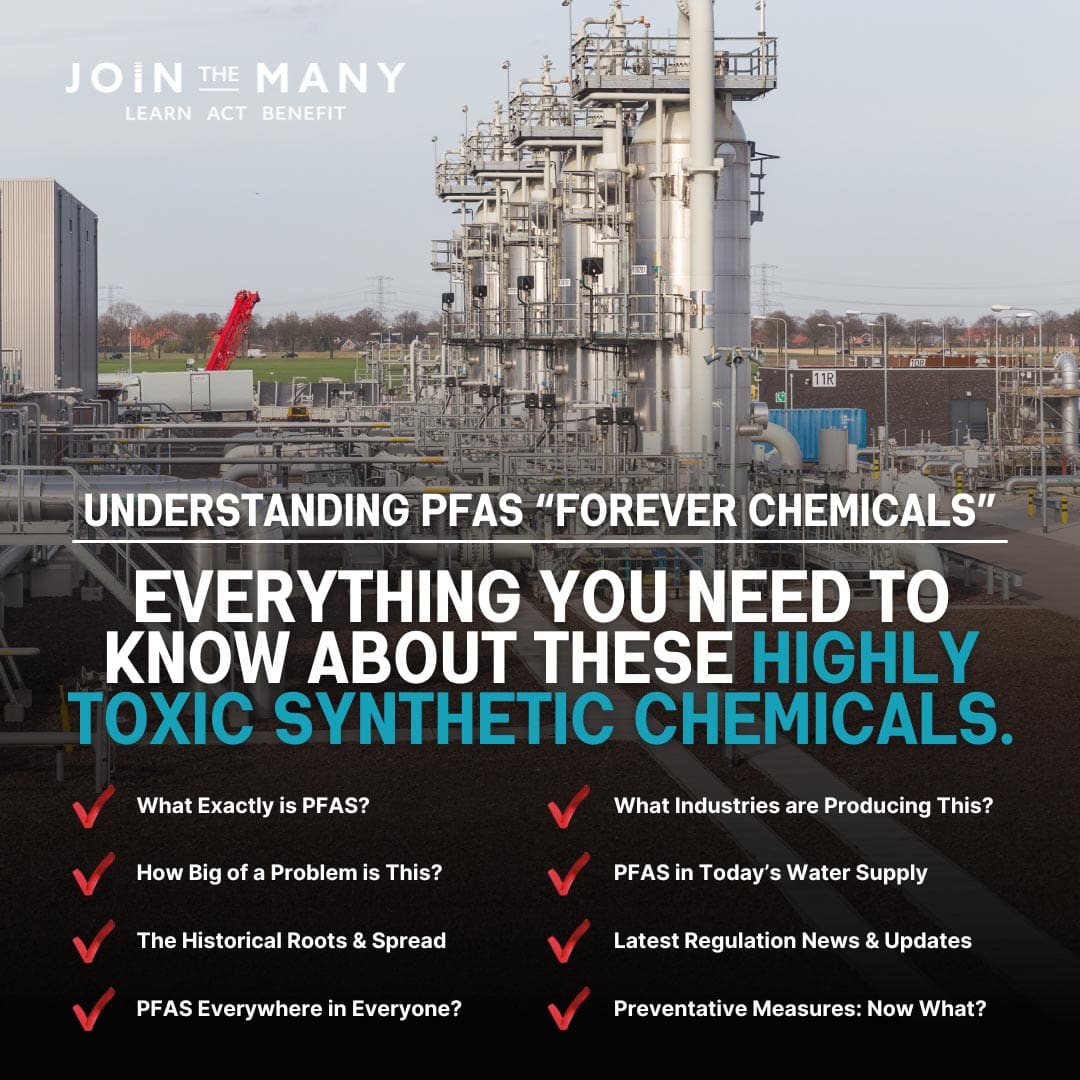
Explore this resource to empower yourself with crucial insights, practical advice, and actionable steps to safeguard the health of your loved ones.
Together, let’s navigate the labyrinth of PFAS contamination, making informed choices for a healthier, toxin-free future.
Depending on where you’re getting your news these days, you’re likely aware of the increasing concerns surrounding Per- and poly-fluoroalkyl substances (PFAS), often referred to as “forever chemicals.”
There’s a good reason, take a look at some of the latest alarming facts we’ve pulled together from various groups who’ve been working hard to shine more light on the often drowned out damages being inflicted upon all of us.

These synthetic compounds, widely used in so many industries, and within most all of our everyday items – have become a pervasive environmental and health threat.
Take a look at this graphic below, where we learned that the majority of the worlds PFAS is coming from 12 producers. ChemSec.org estimates the global societal costs to be $17.5 TRILLION, per year… $17.5 TRILLION per year – to address remediation, health care, etc.
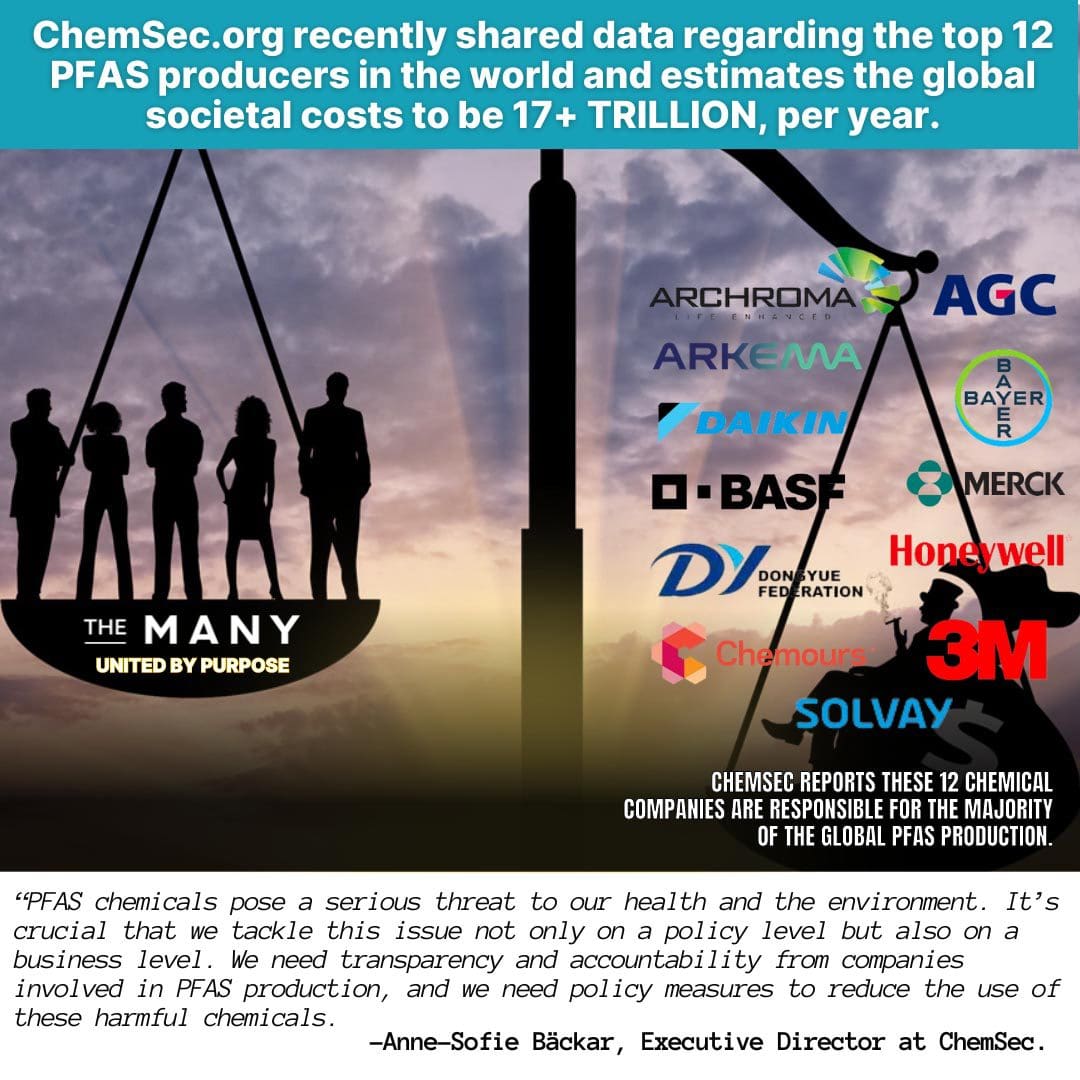
Similar to the Bayer Monsanto Roundup Litigation, and the Johnson & Johnson Talcum Powder Lawsuits, this challenge with PFAS bears resemblance… in the facts that many of these companies knew the dangers and continued to maneuver through regulatory bodies while allowing for brands to tout the safety and efficacy.
Yes, light is being shined upon this PFAS issue, but this “forever chemical” situation appears to be so much bigger than anything we’ve faced as a society, to date.
It is literally everywhere, impacting most everything.
More collective efforts are required – to help swing the pendulum of justice in the right direction.
→ Scroll below to jump towards the sections you’re most concerned with.
As always, all graphics within this web page were created with the intentions of being highly shareable. Feel free to tag us or don’t.
Whatever works for you, just help us get more eyeballs on this issue – as it’s another one that’s silently beating up our immune systems, unnecessarily.
Relevant PFAS Hashtags to Include:
#PFAS #ForeverChemicals #EverywhereChemicals #EDCs #DupontKnew #3MKnew #BigChem #EnoughIsEnough #TheMany #ConcernedParents #UnitedByPurpose
Individuals, Organizations & Others to Include and/or Hashtag:
@EPA @EWG @PFASActionGroup @BennettPeer @DarkWatersMovie @CenterEnvHealth @IPCPch @NOAA
And for those who may be as fed up as we are… Have at it!
#EnoughIsEnough #TheMany #PissedOffParents #StopPoisoningUs #PFAS #Cancer #EPADoBetter
Perfluorinated chemicals (PFAS) constitute a group of synthetic substances utilized in everyday products, including nonstick cookware, stain-resistant clothing, firefighting foams, and food packaging.

Earning the moniker “forever chemicals,” they resist degradation in nature, persisting for years and posing health risks such as cancer, thyroid disease, hormone disruption, and reproductive issues.
The transference of PFAS from mother to child through the placenta or breast milk intensifies their impact.

Make no mistake, PFAS is 100% a Global Crisis.

PFAS are known Endocrine Disruptors (EDCs). The information below is from a recent study that was published highlighting the negative effects upon expecting mothers and their children.

Introduced over 50 years ago, PFAS found its way into common household products due to its dirt and water-repellent properties and heat resistance.

Here is a visual showcasing how PFAS has infiltrated all aspects of life:
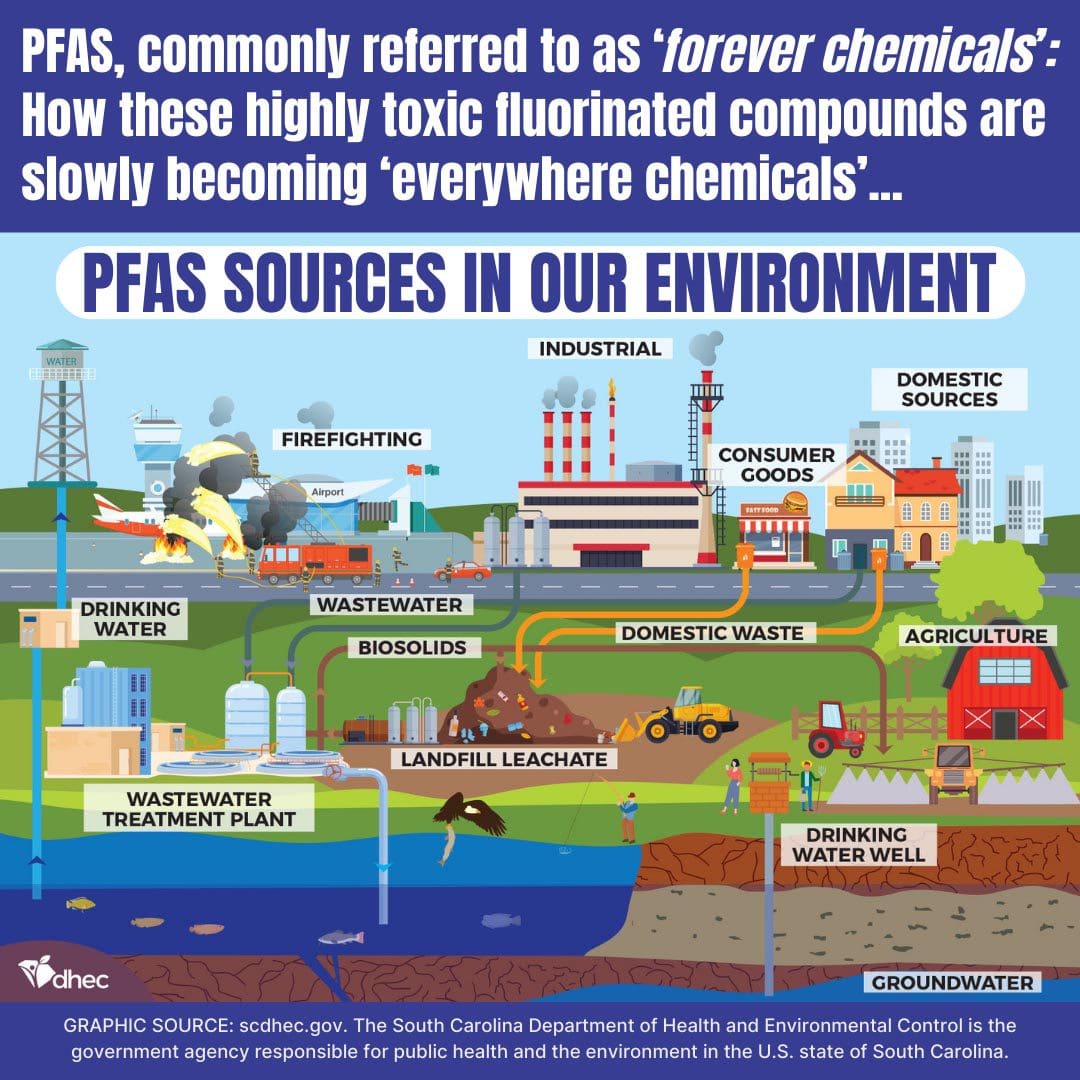
Take a look at “The DuPont PFAS Timeline” pulled from the monster 719 page report that was put together by the folks at EWG.
1950 – 3M mice study reveals that PFAS builds up in blood.
1956 – Stanford University study finds that PFAS binds to proteins in human blood.
1961 – DuPont toxicologist warns that PFAS chemicals enlarge rat and rabbit livers.
1962 – Volunteers who smoke PFAS-laced cigarettes get “polymer fume fever.”
1963 – 3M technical manual deems PFAS toxic.
1965 – DuPont rat study shows liver damage and increased spleen size.
1966 – The Food and Drug Administration rejects a DuPont petition to use PFAS chemicals as a food additive, citing liver studies.
1966 – 3M study finds that PFAS causes “acute oral toxicity” in rats.
1970 – 3M warns Fire Journal, the magazine of the National Fire Protection Association, that PFAS is toxic to fish.
1970 – DuPont scientists say PFAS is “highly toxic when inhaled.”
1973 – DuPont finds there is no safe level of exposure to PFAS in food packaging.
1975 – 3M is informed that PFAS builds up in human blood samples.
1975 – DuPont warns 3M about “toxic effects” of PFAS in food packaging.
1977 – 3M tests workers and animals to measure PFAS in blood.
1977 – 3M finds PFOS, the PFAS chemical in the company’s Scotchgard fabric treatment, “more toxic than anticipated.”
1978 – 3M animal tests find lesions on spleen, lymph nodes and bone marrow.
1978 – 3M concludes that PFOS and PFOA, a PFAS chemical used to make DuPont’s Teflon, “should be regarded as toxic.”
1979 – DuPont survey of employees in its Parkersburg, W.Va., Teflon plant finds possible evidence of liver damage.
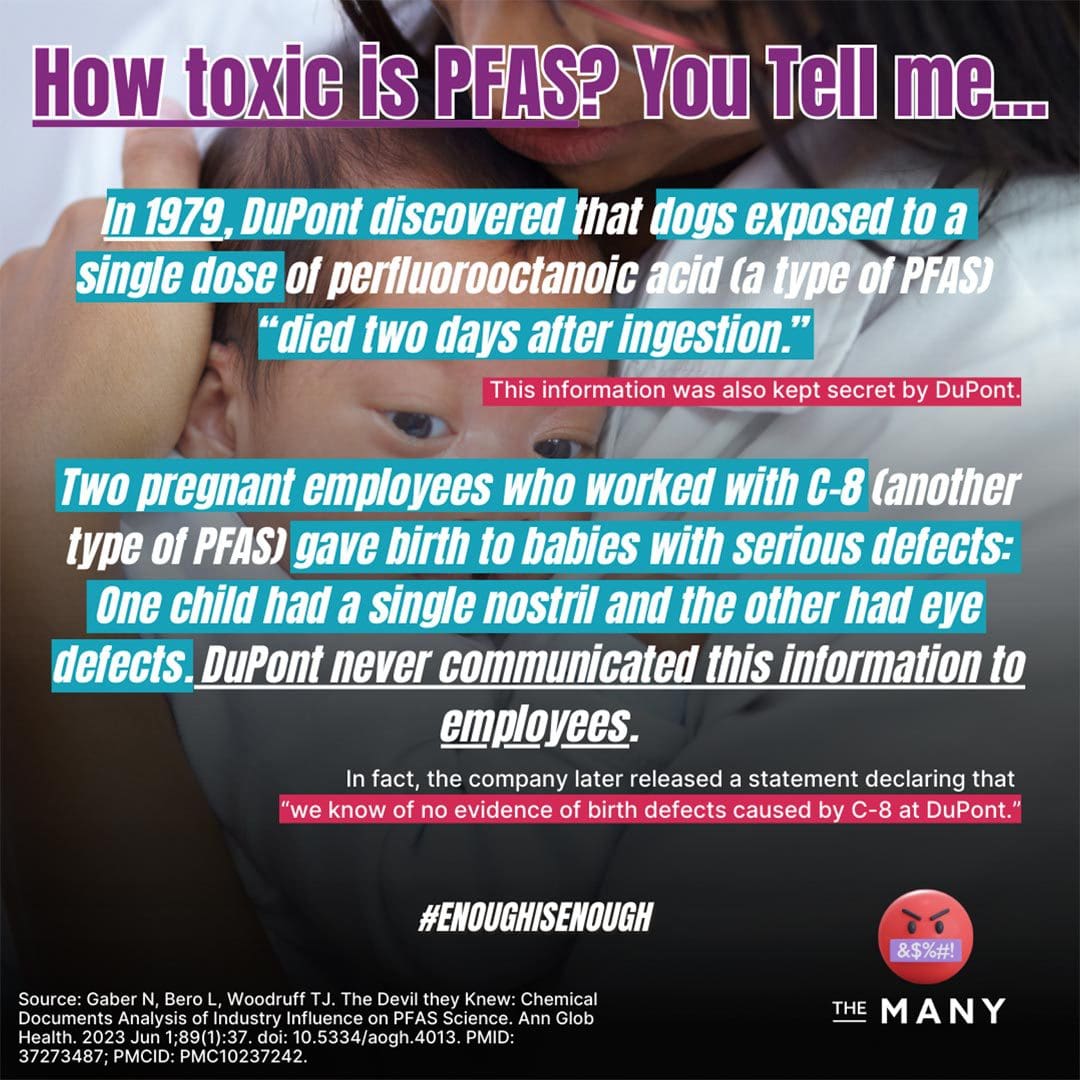
1981 – 3M and DuPont reassign female workers after animal studies reveal PFAS damages the eyes of the developing fetus.
1983 – 3M identifies PFAS’ potential harm to the immune system as a cause for concern.
1984 – 3M documents rising fluorine levels in workers’ blood.
1984 – DuPont detects PFAS in the tap water in Little Hocking, Ohio, but does not alert the local water utility.
1987 – 3M PFOA animal study finds tumors.
1989 – 3M study finds elevated cancer rates among PFAS workers.
1990 – 3M study finds risk of testicular cancer from exposure to PFOA, also known as C8.
1992 – DuPont study finds elevated cancer rates among workers.
1992 – Former 3M scientist finds male PFOA workers more likely to die from prostate cancer.
1995 – DuPont scientist expresses concern over long-term PFAS health effects.
1997 – DuPont study finds heightened cancer rates among workers at the Parkersburg plant.
1998 – 3M scientists report that PFAS moves through the food chain.
1998 – 3M provides EPA evidence that PFAS accumulates in blood.
1998 – 3M animal study finds liver damage from PFAS exposure.
1999 – 3M scientist describes PFOS as “the most insidious pollutant since PCB.”
2000 – 3M animal study finds liver damage from PFOS exposure.

Feel free to download and view the full report.
Popular Question: Are these PFAS compounds related to what went down at the Camp Lejeune Marine Corp Base? Where Veterans, Family Members and Civilians were negatively impacted?
Yes. You can read more about this situation here.
We suspect more of these situations popping up as more light continues to be shined on this topic. Military bases like Camp Lejeune Marine Corps Base in North Carolina faced high PFAS contamination levels, affecting thousands of veterans through prolonged exposure.
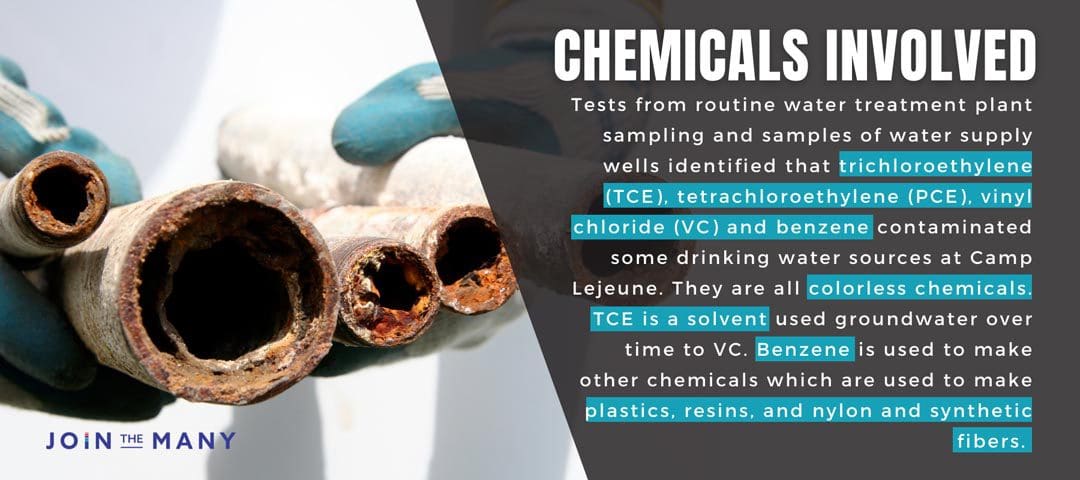

“Latest EPA data show millions more have ‘forever chemicals’ than originally projected. The Centers for Disease Control and Prevention has detected PFAS in the blood of 99 percent of Americans, including newborn babies.”
Environmental Working Group Press Release, “New EPA data show millions more have ‘forever chemicals’ in drinking water” – November 9, 2023
PFAS, introduced in the 1950s, pervades nonstick cookware, household products, firefighting foams, and industrial processes.
Per latest reporting, Michigan is by far the leading state when it comes to toxic contamination. The following are other states with severe PFAS contamination, some of which are also home to military bases – more than likely there is a common denominator to pay attention to.

Their resistance to breakdown in nature leads to persistent soil and water contamination, contributing to a range of health hazards, including adverse reproductive outcomes, increased cholesterol and liver damage, heightened risk for kidney and thyroid diseases, and altered immune function.
“Thyroid cancer risk from PFAS exposure remains a global concern, especially due to rising rates among children.”
The Lancet, “Per- and polyfluoroalkyl substances (PFAS) exposure and thyroid cancer risk” – October 24, 2023

Their resistance to breakdown in nature leads to persistent soil and water contamination, contributing to a range of health hazards, including adverse reproductive outcomes, increased cholesterol and liver damage, heightened risk for kidney and thyroid diseases, and altered immune function.
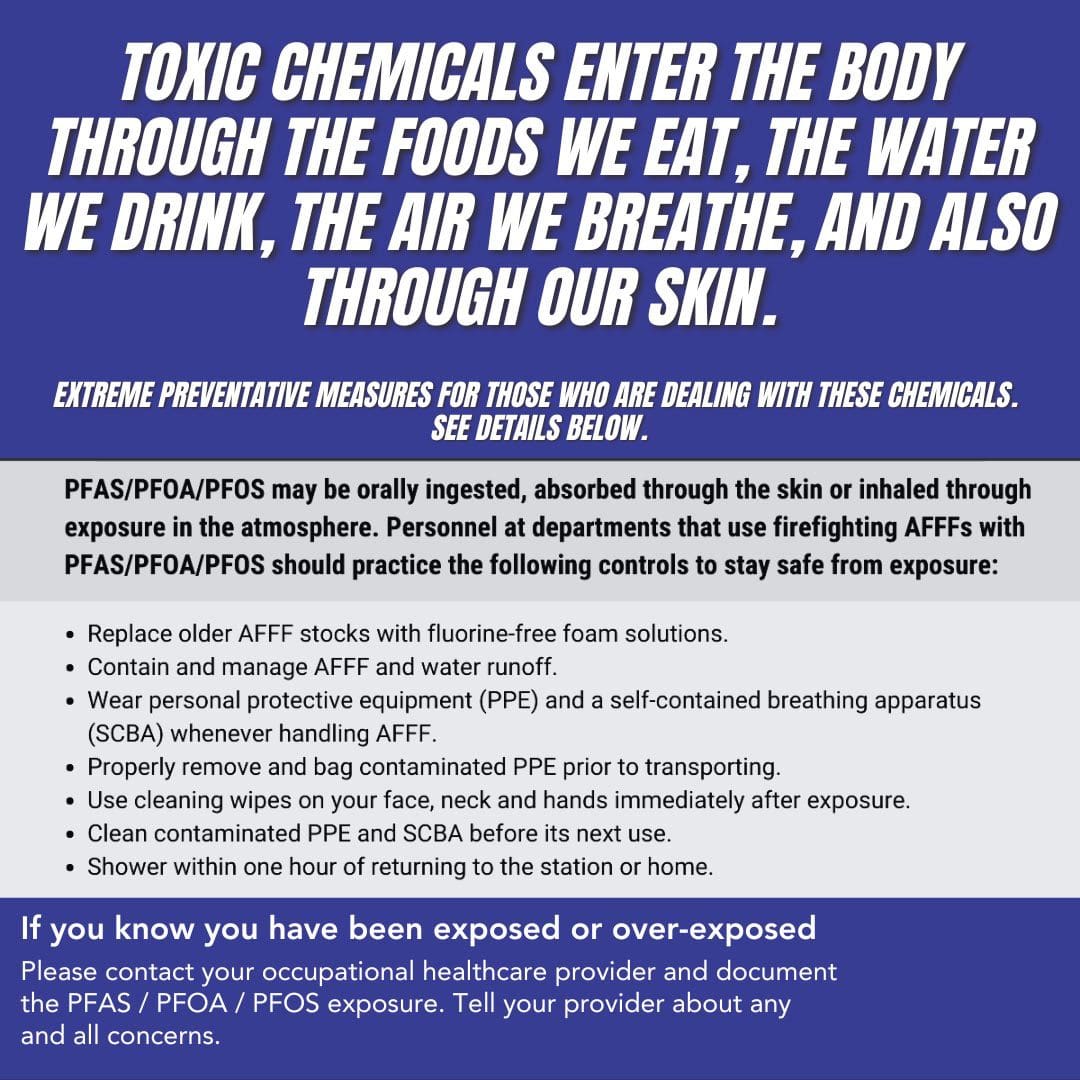
One reason why nearly all Americans, including newborn babies, have PFAS in their blood is because these chemicals are found in many everyday products and can enter the body through ingestion, inhalation, and skin contact. PFAS can be found in drinking water, food, and air, and can also be passed from a pregnant woman to her developing fetus.
Another reason is that PFAS have a long half-life in the body, which means they can take a long time to break down and leave the body. This allows PFAS to accumulate in the body over time, resulting in the high levels of PFAS that are found in many Americans.

Furthermore, PFAS are so prevalent in the environment that it’s difficult to avoid exposure to them completely.
While it’s possible to take steps to reduce exposure, such as using PFAS-free products and drinking filtered water, it’s nearly impossible to eliminate exposure altogether.
Overall, the widespread presence of PFAS in Americans, including newborn babies, is a result of their persistent nature, prevalence in everyday products, and accumulation in the environment and the human body over time.

Once you become aware of how much, it impacts every buying decision.
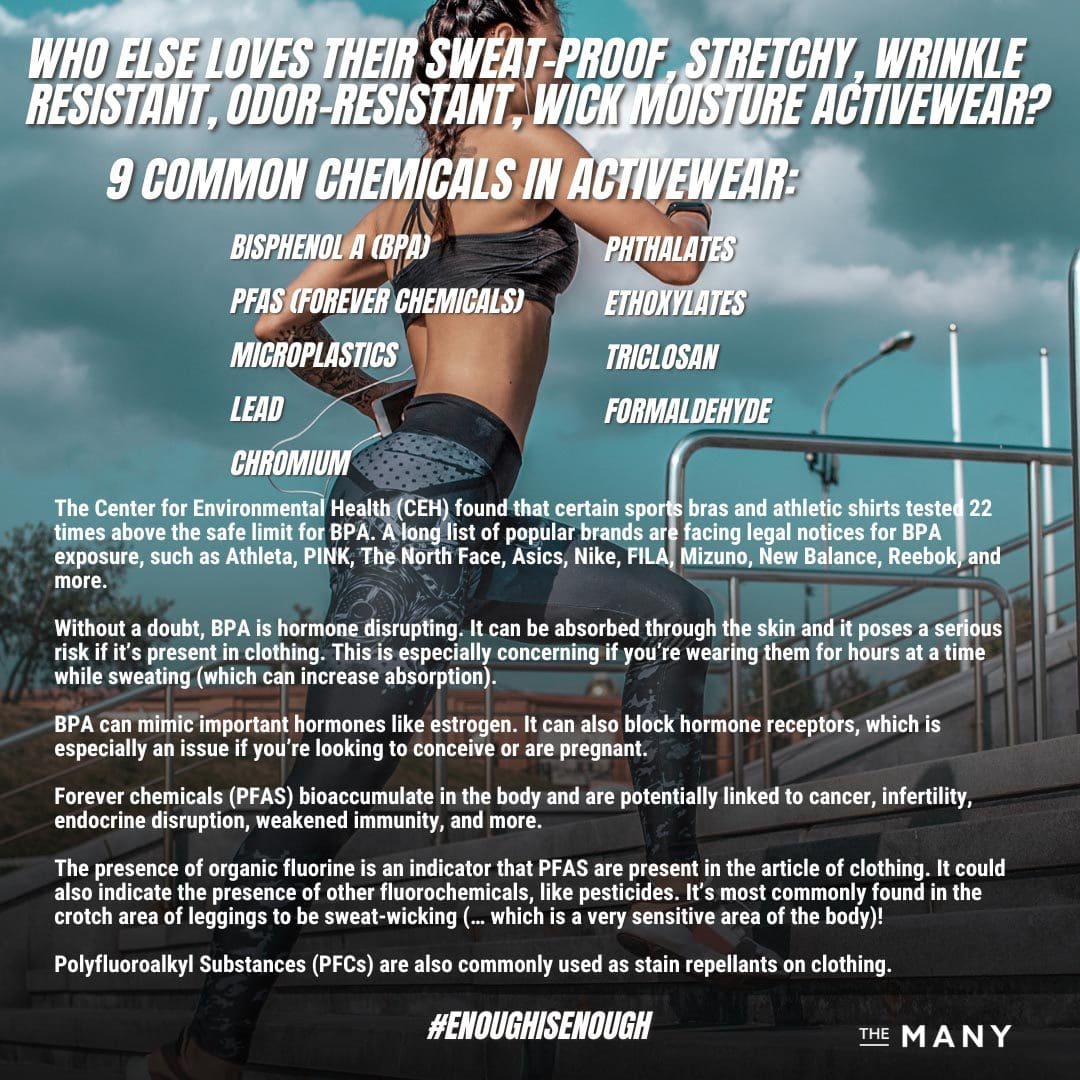
The lack of Food and Drug Administration (FDA) testing in certain areas, such as food packaging, raises concerns about PFAS exposure through everyday items like ice cream sandwiches, canned soup, and pizza.

From cosmetics to clothing, firefighting foams to landfills, PFAS infiltrates numerous sectors. Recent attention has been drawn to its presence in firefighting foams, where the chemicals, essential for flame suppression, pose environmental contamination risks post-fire.
Below is some positive news that was recently spotlighted… How many of you have kids playing recreational sports at parks where they’ve installed the easier-to-maintain ‘artificial turf’?
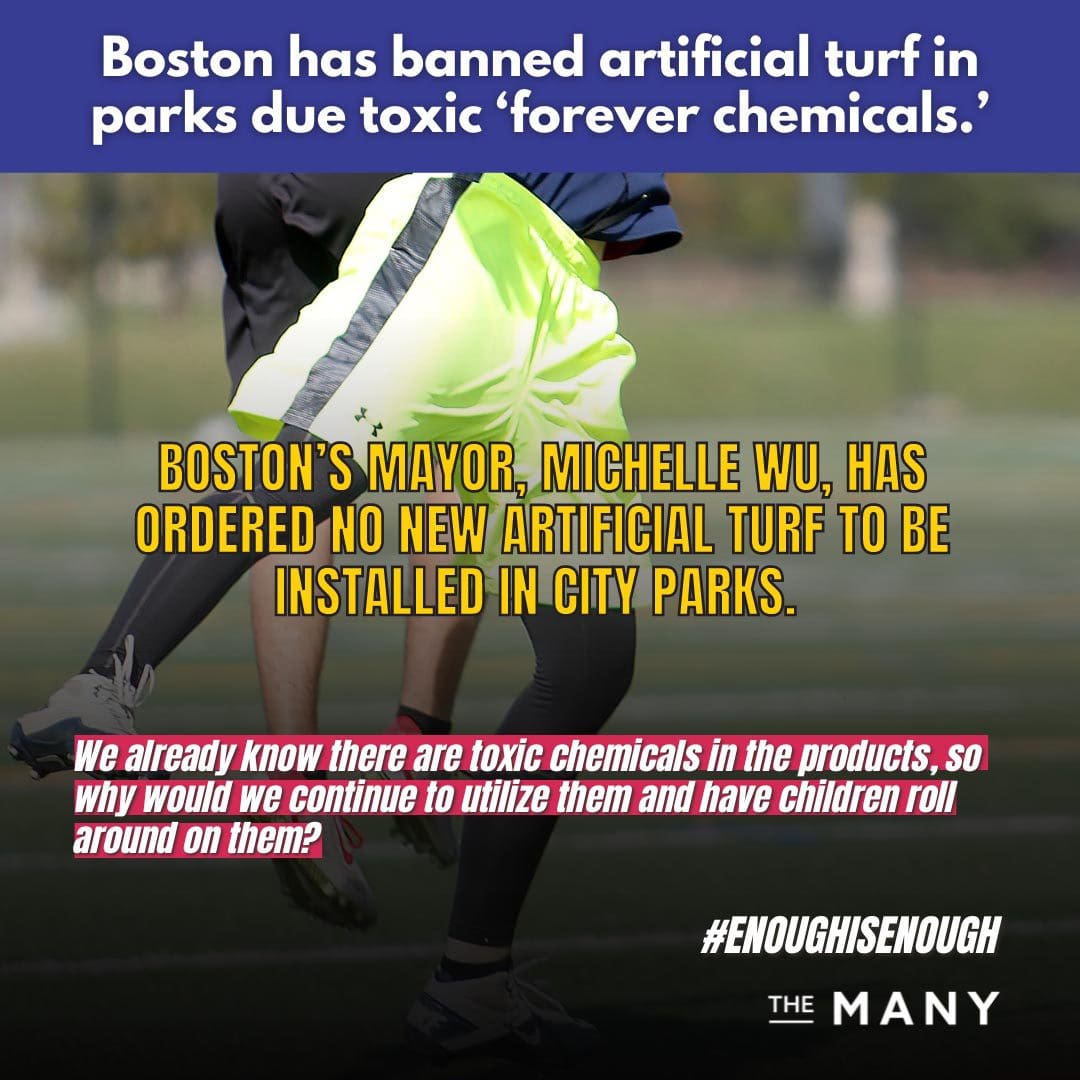

The water you drink is mission-critical for cleansing, detoxification, and cellular regeneration.
Water contamination remains a significant concern, with PFAS leaching into groundwater and resisting conventional treatment methods in wastewater facilities.
Did anyone catch this recent news re: Toilet Paper?
You now know that our skin is our first line of defense when it comes to immune function.

Now think about the skin that is touched via a known carcinogen – where this is occurring daily… regardless of how good you are at shopping for better foods, better water, better clothes… and for those of you who know that sweat is one of our bodies best ways to detoxify and keep our immune system in top condition?
The EPA regulates drinking water under the Safe Drinking Water Act, yet the lack of federal bans or restrictions leaves private wells and groundwater vulnerable.

Despite the EPA’s PFAS Roadmap in 2021, federal bans or restrictions are still ‘in the works’, emphasizing the need for urgent action to protect public health.
See below:
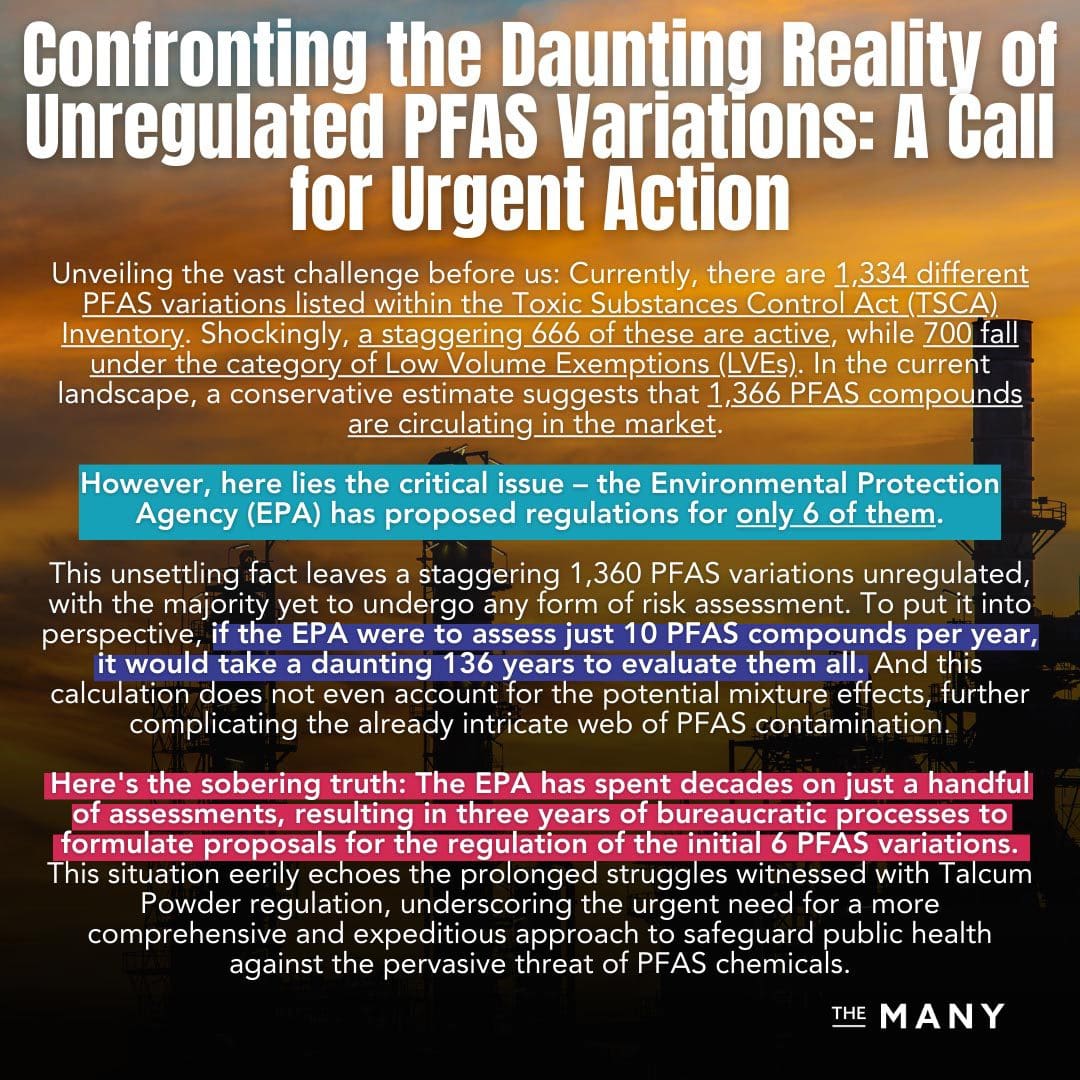
Reflect on the information in this graphic above.
It’s taken the length of the entire pandemic period to get to a point to where the EPA has ‘proposed regulations’ for just 6 PFAS compounds… Meanwhile – every time the scientists dig deeper into testing for contamination; the numbers get worse.
And Bottled Water isn’t going to cut it…
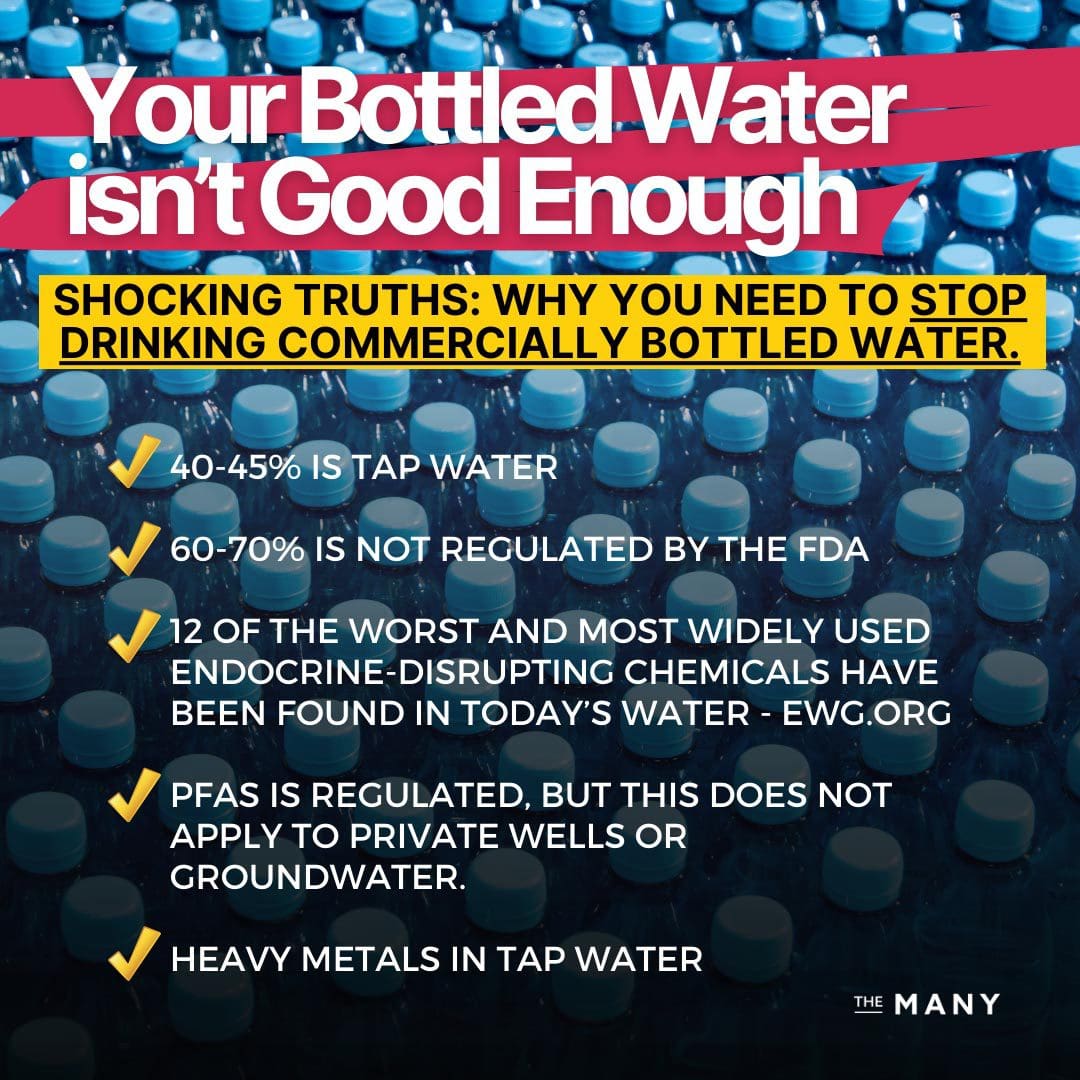
Nor is SPARKLING… which I know for many – has been a highly promoted and accepted alternative – to ensure the water being consumed is as toxin-free as possible.

When we reflect on the “why” and the “how” – many thoughts come to mind… is this purely a matter of human nature playing out in front of us – where the strongest have become the entrepreneurs – who work at a higher pace – knowing there is more of a financial return to be had?
Are these big corps simply outperforming the Government’s “federal employees” who are showing up to get their steady paycheck – doing just enough to ensure they aren’t fired…
Or is it a mixture of both. AND because there is so much profit to be had for these Big Corps – they’re also willing to dole out money in various ways via lobbying and other means?
Definitely something to think about – and call out.
To mitigate PFAS exposure, individuals can adopt lifestyle changes, including a diet rich in fiber, regular exercise, and ample water consumption.
Our body operates best when we’re moving every day. You’re made up of 70% or so of water… water in our muscles, digestive system, bloodstream… we’re mostly water.
Think about that. What happens when a body of water lacks movement… mosquitoes and other harmful toxins begin to breed… well – you’ve got to make time to move. Go for a walk with a friend, by yourself in nature, and get out into the sun for at least 20-45 minutes a day if possible. Nature is healing and movement is how we help our bodies of life within to engage and do what they’re created to do.
Here is one tip that more people need to be talking about…
We Americans – have been programmed to eat so much. When we overeat – all our bodies of life within become maxed out.
Ever notice how immediately after a heavy meal – you want to take a nap?
Well that’s your body’s way of telling you:
“Hey Mr… Hey Mrs… we’re going to need you to lay down so we can figure out how the heck we’re going to address everything you just stuffed down your pie hole.”
It is so important to give your body an opportunity to ‘catch up’… when we FAST… even for 8-12 hours – we give our bodies of life within an opportunity to re-direct energy to the things that oftentimes get left out during our natural detoxification process.
How the heck do we tackle this problem – recognizing there is so much that is simply out of our control?
SHARE. Every time you see someone or a group sharing helpful information about issues that fall within this PFAS matter, the Water Problem, or more of an integrated approach to help your body heal – absorb, learn, share, and grow.
When the big bad monster in the closet is confronted – the fear can become replaced with confidence and hope.
Every one of these creative graphics we take time to put together, we’re doing this to help you share… some are more fun… and sometimes we need to address the serious news.
The more you learn about all these things that seem to be proactively ‘out to get us’ – the more you/we/us begin to recognize one of the primary obstacles in front of us – that’s been preventing us from making progress in the past.
The divide and conquer dynamic needs to go away. Our health and safety are not a left vs right, blue vs red, or Democrat vs Republican issue…
At least, it shouldn’t be.
This is a MANY vs THEM issue. It’s a 99% of the entire human population vs the 1% issue.
Where this 1% or whatever the precise number is – hasn’t been making decisions from the right place, for a long time now.
The root of their decisions has been based on power, money, and control… whereas the all-mighty fiat currency has been the deciding factor… profit margins… EBITDA… Market Share… Stockholder Share Value.
This old nasty root has created most all of the messes we’re experiencing today.
Every decision made should be based on the following: Is this truly in the best interest of those I love most? My family, friends, neighbors, etc. Because if the answer is NO, then it’s back to the drawing board.
The moment these big company executives learned that there was a toxic chemical or harmful carcinogen issue that was proving to have negative effects on whatever testing mechanisms were being used – a huge red flag and alarm bell should have gone up and off.
This did not occur with Bayer (formerly Monsanto) with their pesticide product, Roundup.
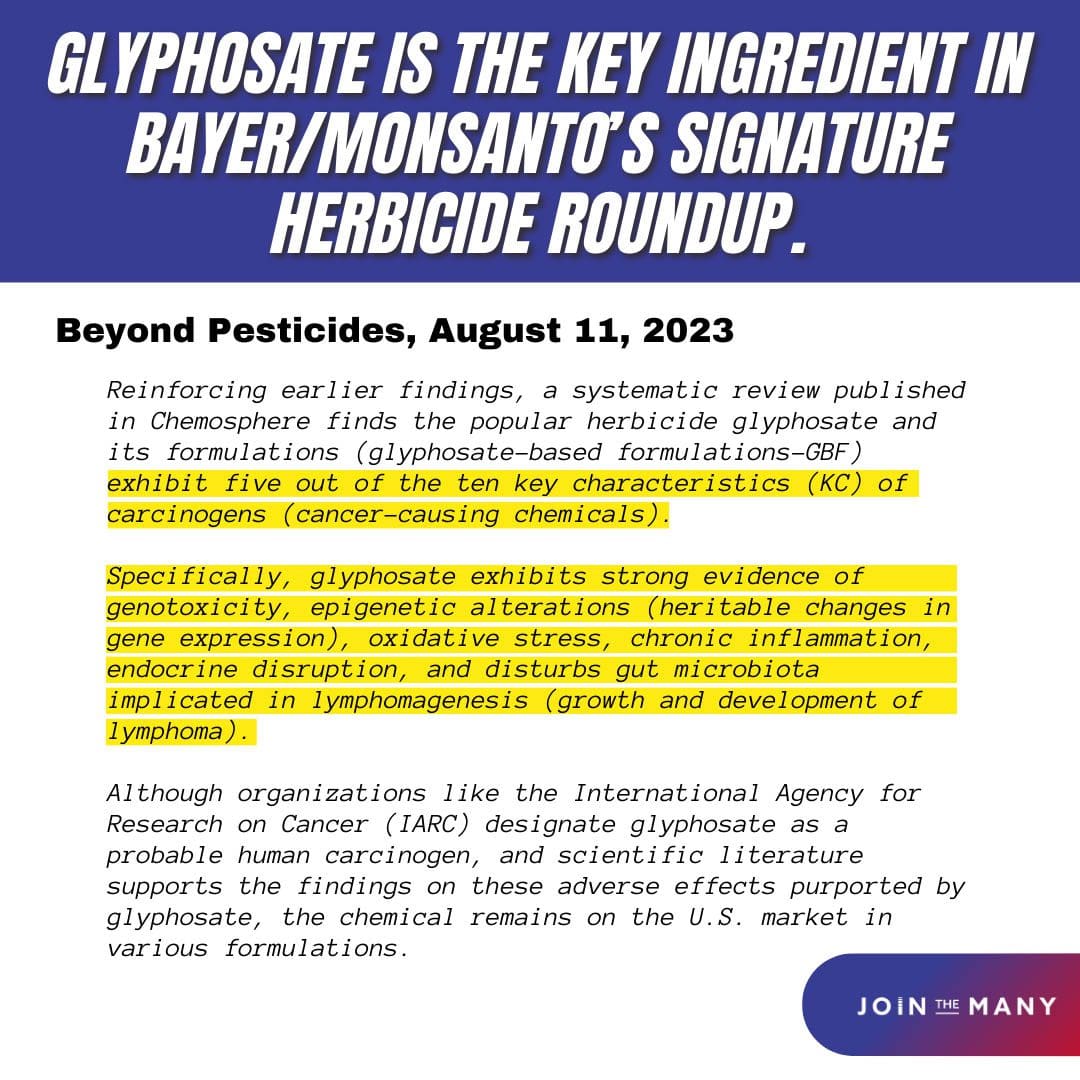
This did not occur with Johnson & Johnson and their Talcum Powder Contamination issue where their own internal scientist shared with them that there was literally no way to avoid asbestos contamination within any of their popular talcum ‘baby powder’ based products.

This did not occur with any of the big 12 producers of PFAS. In fact – there is more proof coming to light that they were ALSO proactively doing whatever possible to avoid any of these negative findings from ever coming to light – while also skirting around the minimal regulatory body restrictions – by producing NEW variations… knowing it was a loophole.
Think about that.
100% Pure corporate negligence.
So how does this get fixed?
With Justice… and Justice requires the Truth… and the more people that know the Truth, the more impossible it will be for these matters to not be addressed with the type of benevolent justice required so that we can move forward, heal, forgive, and co-create a better world for our families today, and our children’s future families, tomorrow.
We already know that MONEY was at the root.
This is precisely why large amounts of cold hard JUSTICE for ANY of the MANY who’ve been negatively impacted is important… so that this type of decision-making never occurs again.
Enough is Enough.
We Will Not Stop.
Justice Will Prevail.
Better Humans, Working Together.
United by Purpose.
We Are The Many.
The 99%.
The Devil they Knew: Chemical Documents Analysis of Industry Influence on PFAS Science
The lack of transparency in industry-driven research on industrial chemicals has significant legal, political and public health consequences. Industry strategies to suppress scientific research findings or early warnings about the hazards of industrial chemicals can be analyzed and exposed, in order to guide prevention.
Polychlorinated Biphenyls (PCBs) via in.gov
From Pollution to Solution: A Global Assessment of Marine Litter and Plastic Pollution
Plastics are the largest, most harmful and most persistent fraction of marine litter, accounting for at least 85 percent of total marine waste. The assessment examines the magnitude and severity of marine litter and plastic pollution and reviews existing solutions and actions. The assessment demonstrates that there is a growing threat from marine litter and plastic pollution in all ecosystems from source to sea. It provides a comprehensive update on current research (and knowledge gaps) with respect to direct impacts on marine life, risks posed to ecosystems and human health, and social and economic costs.
EPA Announces New Framework to Prevent Unsafe New PFAS from Entering the Market
“For decades, PFAS have been released into the environment without the necessary measures in place to protect people’s health – but with this framework, EPA is working to reduce the risk posed by these persistent contaminants,” said Assistant Administrator for the Office of Chemical Safety and Pollution Prevention Michal Freedhoff. “EPA’s new framework will ensure that before any new PFAS enter the market, these chemicals are extensively evaluated and pose no risk to people’s health or the environment.”
Under the Toxic Substances Control Act (TSCA) section 5, EPA is required to review new chemicals, including new PFAS and new uses of PFAS, within 90 days, assess the potential risks to human health and the environment of the chemical, and make one of five possible risk determinations. When potential risks are identified, EPA must take action to mitigate those risks before the chemical can enter commerce.
PCBs: Why Are Banned Chemicals Still Hurting the Environment Today?
FEB. 7, 2014 — For the United States, the 20th century was an exciting time of innovation in industry and advances in technology. We were manufacturing items such as cars, refrigerators, and televisions, along with the many oils, dyes, and widgets that went with them. Sometimes, however, technology races ahead of responsibility, and human health and the environment can suffer as a result. This is certainly the case for the toxic compounds known as polychlorinated biphenyls, or PCBs.
PCB contamination is high in the Housatonic River and New Bedford Harbor in Massachusetts. How high? The “highest concentrations of PCBs ever documented in a marine environment.” (U.S. Fish and Wildlife Service)
From the 1920s until they were banned in 1979, the U.S. produced an estimated 1.5 billion pounds of these industrial chemicals. They were used in a variety of manufacturing processes, particularly for electrical parts, across the country. Wastes containing PCBs were often improperly stored or disposed of or even directly discharged into soils, rivers, wetlands, and the ocean. Unfortunately, the legacy of PCBs for humans, birds, fish, wildlife, and habitat has been a lasting one.
PFOA in rain worldwide exceeds EPA advisory level
Based on the latest US guidelines for PFOA in drinking water, rainwater everywhere would be judged unsafe to drink,” says Ian Cousins, an environmental organic chemistry professor at Stockholm University, who led the research.
EPA orders company to stop making plastic containers that leach toxic PFAS
The US Environmental Protection Agency (EPA) has ordered a major company to stop producing hundreds of millions of plastic containers each year that contain toxic per- and polyfluoroalkyl substances (PFAS), which leach into countless products.
The so-called “forever chemicals” are produced by a fluorination technique that Inhance Technologies uses to prevent liquids from leaking out of high-density polyethylene (HDPE) plastic containers. The PFAS can leach into pesticides, personal care products, household cleaners, condiments, and many other liquids stored within the containers.
“I’m stunned but pleased that EPA took such strong action and hoping the decision remains intact through whatever court case Inhance is going to bring,” said Kyla Bennett, the science policy director for the watchdog group Public Employees for Environmental Responsibility (PEER) and a former EPA employee. “It wasn’t easy getting them there, but they got there and that’s what matters.”
EWG’s Tap Water Database: Check Your Water Quality Today
The Environmental Protection Agency recently proposed new limits to tackle drinking water contamination from the toxic “forever chemicals” known as PFAS. The proposal targets six notorious PFAS: PFOA, PFOS, PFNA, PFHxS, PFBS and GenX.
The limits, known as maximum contaminant levels, or MCLs, are the highest level of a contaminant allowed in drinking water. The MCLs announced are 4 parts per trillion, or ppt, for PFOA and 4 ppt for PFOS. For the other four PFAS the agency is proposing using a “hazard index” which is a tool used to address cumulative risks from mixtures of chemicals.
This is an active lawsuit. Stay informed on how it's unfolding.